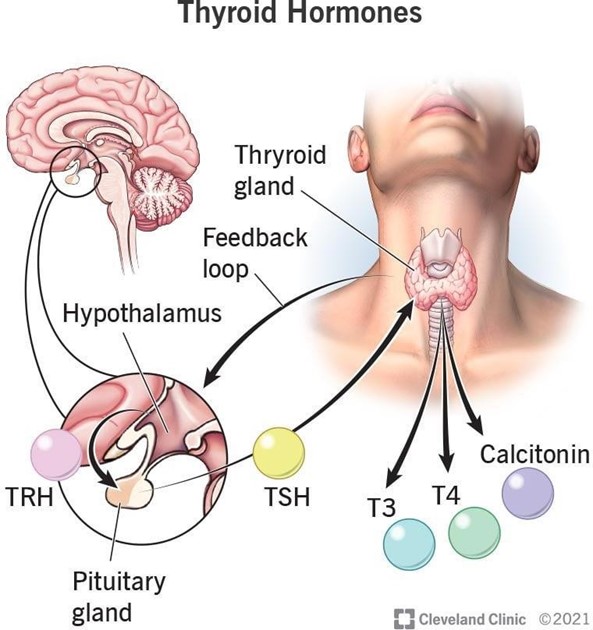A nurse is caring for a client who has a prescription for levothyroxine.
Which of the following laboratory tests should the nurse monitor?
Serum potassium
Triiodothyronine
Blood urea nitrogen
Prothrombin time
The Correct Answer is B
Explanation B.Triiodothyronine
Levothyroxine is a synthetic form of the thyroid hormone thyroxine (T4). It is converted to triiodothyronine (T3), the active form of the thyroid hormone, in the body. Monitoring the levels of triiodothyronine (T3) can help assess the effectiveness of levothyroxine therapy and ensure that the client's thyroid hormone levels are within the desired therapeutic range.
Serum potassium levels in (option A) should not be monitored because they are not directly affected by levothyroxine. However, imbalances in electrolytes can occur in some individuals with thyroid disorders. Electrolyte levels may be monitored, but it is not the primary focus of monitoring for levothyroxine therapy.
Blood urea nitrogen (BUN) in (option C) should not be monitored because it is a test used to assess kidney function and is not directly related to monitoring levothyroxine therapy.
Prothrombin time (PT) in (option D) should not be monitored because it is a test used to evaluate the clotting function of the blood and is not specifically related to monitoring levothyroxine therapy.

Nursing Test Bank
Naxlex Comprehensive Predictor Exams
Related Questions
Correct Answer is A
Explanation
Explanation:
Methylenedioxyphenol-methamphetamine (MDMA), also known as ecstasy or Molly, is a psychoactive substance that can produce hallucinations as one of its effects. Hallucinations involve perceiving things that are not present in reality, such as seeing, hearing, or feeling things that do not actually exist.
Muscle weakness (choice B) is not a common finding associated with MDMA use. In fact, MDMA typically produces an increase in energy and heightened physical sensations rather than muscle weakness.
Hypothermia (choice C) can occur as a result of MDMA use. MDMA can interfere with the body's ability to regulate temperature, leading to an increase in body temperature. This is commonly known as "drug-induced hyperthermia" rather than hypothermia.
Somnolence (choice D), which refers to excessive sleepiness or drowsiness, is not typically associated with MDMA use. MDMA is a stimulant drug that can produce increased wakefulness and alertness.
Correct Answer is B
Explanation
The response acknowledges the client's feelings and validates their experience without reinforcing or denying the delusion. It demonstrates empathy and invites further exploration of the client's concerns. Open-ended statements like this can encourage the client to express their thoughts and feelings, allowing for therapeutic communication and building trust between the client and nurse.
"The psychiatric staff is not FBI. They are here to help you." This response directly contradicts the client's belief and may lead to increased distrust or resistance. It is important to avoid directly challenging delusions or imposing one's own reality on the client, as it can escalate their distress.
"What makes you think the staff is following you?" While this response seeks more information, it may inadvertently reinforce or amplify the client's delusion. It could be interpreted as confirmation or validation of their belief, potentially increasing anxiety or paranoia.
"Why do you feel the staff is the FBI?" This response also seeks more information, but it may come across as challenging or dismissive. It could potentially trigger defensiveness or hostility in the client. It is important to approach the client's beliefs with empathy and respect rather than questioning or interrogating them.
Whether you are a student looking to ace your exams or a practicing nurse seeking to enhance your expertise , our nursing education contents will empower you with the confidence and competence to make a difference in the lives of patients and become a respected leader in the healthcare field.
Visit Naxlex, invest in your future and unlock endless possibilities with our unparalleled nursing education contents today
Report Wrong Answer on the Current Question
Do you disagree with the answer? If yes, what is your expected answer? Explain.
Kindly be descriptive with the issue you are facing.
